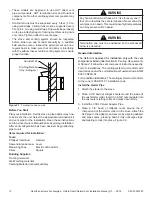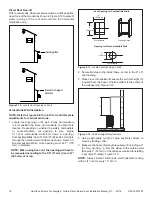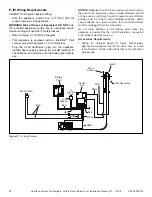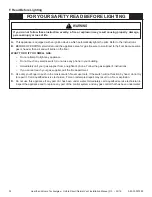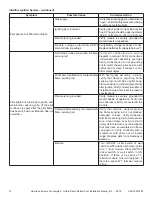
23
23
3-90-30007480
Hearth and Home Technolgies • Oxford Direct/Natural Vent Installation Manual_R3 • 02/19
4
Gas Information
A. Fuel Conversion
• Make sure the appliance is compatible with available gas
types.
• Conversions must be made by a qualified technician
using Hearth & Home Technologies specified and
approved parts.
B. Gas Pressure
• Optimum appliance performance requires proper input
pressures.
• Gas line sizing requirements will be determined in ANSI
Z221.3 National Fuel Gas Code in the USA and CAN/
CGA B149 in Canada.
• Pressure requirements are:
Gas Pressure
Natural Gas
Propane
Minimum Inlet Pressure
5.0 in. w.c.
11.0 in. w.c.
Maximum Inlet Pressure
10.0 in. w.c.
13.0 in. w.c.
Manifold Pressure
3.5 in. w.c.
10.0 in. w.c.
WARNING! Risk of Fire/Explosion!
High pressure will
damage valve. Low pressure may cause explosion.
• Verify inlet pressures. Verify minimum pressures when
other household gas appliances are operating.
• Install regulator upstream of valve if line pressure is
greater than 1/2 psig.
Note:
Have the gas supply line installed in accordance with
local codes, if any. If not, follow ANSI 223.1. Installation
should be done by a qualified installer approved and/or
licensed as required by the locality. (In the Commonwealth
of Massachusetts installation must be performed by a
licensed plumber or gas fitter).
Note:
A listed (and Commonwealth of Massachusetts
approved) 1/2 inch (13 mm) T-handle manual shut-off valve
and flexible gas connector are connected to the 1/2 inch (13
mm) control valve inlet.
• If substituting for these components, please consult
local codes for compliance.
C. Gas Connection
• Pipe incoming gas line into valve compartment.
• Connect incoming gas line to the 1/2 in. (13 mm)
connection on manual shutoff valve.
WARNING! Risk of Fire/Explosion!
Support control when
attaching pipe to prevent bending gas line.
• A small amount of air will be in the gas supply lines.
WARNING! Risk of Fire/Explosion!
Gas build-up during
line purge could ignite.
• Purge should be performed by a qualified technician.
• Ensure adequate ventilation.
• Ensure there are no ignition sources such as sparks or
open flames.
Light the appliance. It will take a short time for air to purge
from lines. When purging is complete the appliance will light
and operate normally.
WARNING! Risk of Fire, Explosion or Asphyxiation!
Check all fittings and connections with a non-corrosive
commercially available leak-check solution. DO NOT use
open flame. Fittings and connections could have loosened
during shipping and handling.
WARNING! Risk of Fire! DO NOT
change valve settings.
This valve has been preset at the factory.
D. High Altitude Installations
NOTICE:
If the heating value of the gas has been reduced,
these rules do not apply. Check with your local gas utility or
authorities having jurisdiction.
When installing above 2000 feet elevation:
• In the USA: Reduce burner orifice 4% for each 1000 feet
above 2000 feet.
• In CANADA: Input ratings are certified without a
reduction of input rate for elevations up to 4500 feet
(1370 m) above sea level. Please consult provincial and/
or local authorities having jurisdiction for installations at
elevations above 4500 feet (1370 m).
Fire Risk, Explosion Hazard.
High pressure will damage valve.
• Disconnect gas supply piping BEFORE
pressure testing gas line at test pressures
above 1/2 psig.
• Close the manual shutoff valve BEFORE
pressure testing gas line at test pressures
equal to or less than 1/2 psig.
WARNING
!







